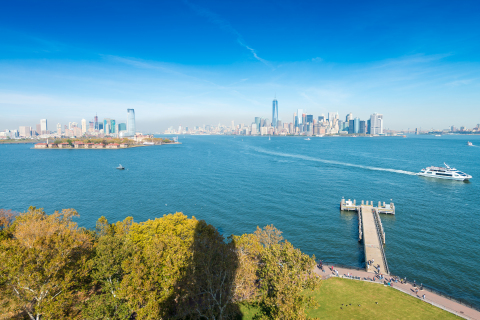With many New York government officials, citizens and organizations calling for further PCB clean-up efforts in the Hudson River, ecoSPEARS has asked General Electric (GE), the U.S. Environmental Protection Agency (EPA) and state officials to consider deploying its NASA-developed Sorbent Polymer Extraction and Remediation System (SPEARS) to rid PCBs in the river, forever. The recently commercialized SPEARS technology extracts the world’s most persistent toxins, like PCBs, from waterways at a fraction of the cost of dredging and without disturbing the aquatic ecosystem and community.
This press release features multimedia. View the full release here: http://www.businesswire.com/news/home/20180124005254/en/

PCBs in Hudson River can be permanently and safely removed with ecoSPEARS, a NASA-developed transformative technology. (Photo: Business Wire)
PCBs—polychlorinated biphenyls—were discharged into the Hudson River from GE capacitor plants from 1946 to 1977. A 2002 EPA consent order required GE to clean up the river and the company spent $1.7 billion on a dredging project to remove the contaminants. With EPA expected to decide on GE’s certificate of completion soon, there has been public outrage that not enough has been done. Federal agencies, New York state agencies, Governor Andrew Cuomo, citizens, businesses and environmental groups contend that levels of PCBs in river fish haven't dropped enough.
“We know a decision will be made soon, and it will be historic. EPA has admitted the cleanup has not reached any of the benchmarks that would show the cleanup to date has worked to protect the health of the river and the public,” said Jay Burgess, the director of communications for the Poughkeepsie-based environmental group Scenic Hudson, in a recent article.
It has been reported that Kathryn Jahn, the U.S. Department of Interior's Hudson River case manager, wrote to the director of the EPA Hudson River Field Office late last year that the department, along with state and National Oceanic and Atmospheric Administration officials, continues to be concerned about significant PCB contamination and its impacts on the river's ecosystem. She said that additional PCB removal and "robust" habitat reconstruction "will accelerate the recovery of the river and its resources, which will reduce restoration required and facilitate the ecological and economic recovery of the Hudson River."
“I grew up just down the road from the Hudson River. It’s heartbreaking that we’re still talking about clean up and that communities are still being impacted,” said Serg Albino, CEO of ecoSPEARS. “It is imperative that officials look at transformative technologies that quickly and inexpensively deliver a permanent clean-up solution. Communities shouldn’t have to settle for partially clean.”
SPEARS is a long-term, permanent solution that has also shown to have powerful short-term effectiveness. When placed in river or lake beds, SPEARS will absorb PCBs and other harmful contaminants from the sediment all while protecting human health and the environment by trapping the harmful contaminants and limiting the threat of re-suspension, as compared to traditional remediation methods.
ecoSPEARS has commercialized the NASA technology to be both scalable and cost-effective. When site-specific PCB levels are achieved, ecoSPEARS removes the SPEARS with the trapped PCBs from the sediments, and uses a proprietary post-process technology to destroy the harmful chemicals. SPEARS is a green remediation technology that the community, state officials, responsible parties, and EPA can all rally behind to rid the river of the persistent PCB contaminants, finally, once and for all.
Developed in 1929, PCBs were widely used across the world as coolants and lubricants in transformers, capacitors and other electrical equipment. The toxic substance was finally banned from production in 1979, but the irreversible damage was done. PCBs are not only persistent in water and on land but also are fat soluble, meaning they can linger for decades in the fatty tissues of living organisms.
PCB contamination has been linked to human cancer as well as liver dysfunction, digestive disorders, headaches, nausea and fatigue. PCBs can also affect the respiratory, immune, nervous systems and cause a variety of reproductive disorders, including male sterility, developmental abnormalities, learning disorders and birth defects.
ecoSPEARS has assembled a brilliant team of innovators, scientists and engineers that have commercialized a NASA-developed, scalable solutions for permanently cleaning-up persistent toxins in water and dry soil.
To learn more about ecoSPEARS, visit: www.ecospears.com.
About ecoSPEARS:
ecoSPEARS is providing America’s polluted waterways a second chance at life through the commercial deployment of NASA-developed, transformative technology. The company’s Sorbent Polymer Extraction and Remediation System (SPEARS) can permanently clean up the world’s most pervasive and persistent toxins from water at a fraction of the cost of dredging and without disturbing the aquatic ecosystem and local community.
Located in Orlando, Fla., the company has assembled a brilliant team of innovators, scientists and engineers, who have developed scalable solutions for cleaning up PCB (polychlorinated biphenyls), PAH (polycyclic aromatic hydrocarbon), PBDE (polybrominated diphenyl ethers), DDT (dichlorodiphenyltrichloroethane), dioxins, and other harmful contaminants in water and dry soil—forever.
ecoSPEARS: Vital. Clean. Brilliant.
For more information, visit www.ecoSPEARS.com or follow the company on Facebook and LinkedIn.
View source version on businesswire.com: http://www.businesswire.com/news/home/20180124005254/en/























